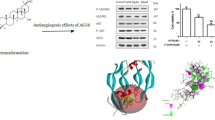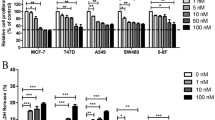Abstract
Antiangiogenesis is now thought of as one of the most important approaches for anticancer therapy. In this study, we determined the antiangiogenic property of herboxidiene, a polyketide natural product. Herboxidiene effectively inhibited the proliferation of human umbilical vein endothelial cells (HUVECs) at concentrations not exhibiting cytotoxicity. Furthermore, the natural product significantly suppressed vascular endothelial growth factor-induced invasion and tube formation in HUVECs as well as neovascularization of the chorioallantoic membrane in developing chick embryos. We also identified an association between the antiangiogenic activity of herboxidiene and the downregulation of both the phosphorylation of VEGF receptor 2 (KDR/Flk-1) and the expression of hypoxia-inducible factor-1α at the transcriptional level. These results suggest that herboxidiene functions as a potential antiangiogenic agent and may be applicable for anticancer therapy by targeting tumor angiogenesis.






Similar content being viewed by others
References
Alphen, R.J., E. Wiemer, H. Burger, and F.A. Eskens. 2009. The spliceosome as target for anticancer treatment. British Journal of Cancer 100: 228–232.
Bussolino, F., A. Mantovani, and G. Persico. 1997. Molecular mechanisms of blood vessel formation. Trends in Biochemical Sciences 22: 251–256.
Cardones, A.R., and L.L. Banez. 2006. VEGF inhibitors in cancer therapy. Current Pharmaceutical Design 12: 387–394.
Carmeliet, P. 2005. VEGF as a key mediator of angiogenesis in cancer. Oncology 69: 4–10.
Carmeliet, P., and R.K. Jain. 2000. Angiogenesis in cancer and other diseases. Nature 407: 249–257.
Eskens, F.A., and J. Verweij. 2006. The clinical toxicity profile of vascular endothelial growth factor (VEGF) and vascular endothelial growth factor receptor (VEGFR) targeting angiogenesis inhibitors; a review. European Journal of Cancer 42: 3127–3139.
Faivre, S., G. Demetri, W. Sargent, and E. Raymond. 2007. Molecular basis for sunitinib efficacy and future clinical development. Nature Reviews Drug Discovery 6: 734–745.
Ferrara, N. 2004. Vascular endothelial growth factor as a target for anticancer therapy. Oncologist 9: 2–10.
Folkman, J. 1995. Clinical applications of research on angiogenesis. The New England Journal of Medicine 235: 1757–1763.
Forsythe, J.A., B.H. Jiang, N.V. Iyer, F. Agani, S.W. Leung, R.D. Koos, and G.L. Semenza. 1996. Activation of vascular endothelial growth factor gene transcription by hypoxia-inducible factor 1. Molecular and Cellular Biology 16: 4604–4613.
Gao, Y., A. Vogt, C.J. Forsyth, and K. Koide. 2013. Comparison of splicing factor 3b inhibitors in human cells. ChemBioChem 14: 49–52.
Hanahan, D., and J. Folkman. 1996. Patterns and emerging mechanisms of the angiogenic switch during tumorigenesis. Cell 86: 353–364.
Hanrahan, E.O., and J.V. Heymach. 2007. Vascular endothelial growth factor receptor tyrosine kinase inhibitors vandetanib (ZD6474) and AZD2171 in lung cancer. Clinical Cancer Research 13: s4617–s4622.
Hasegawa, M., T. Miura, K. Kuzuya, A. Inoue, S.W. Ki, S. Horinouchi, T. Yoshida, T. Kunoh, K. Koseki, and K. Mino. 2011. Identification of SAP155 as the target of GEX1A (Herboxidiene), an antitumor natural product. American Chemical Society Chemical Biology 6: 229–233.
Höckel, M., and P. Vaupel. 2001. Tumor hypoxia: definitions and current clinical, biologic, and molecular aspects. Journal of the National Cancer Institute 93: 266–276.
Hoeben, A., B. Landuyt, M.S. Highley, H. Wildiers, A.T. Van Oosterom, and E.A. De Bruijn. 2004. Vascular endothelial growth factor and angiogenesis. Pharmacological Reviews 56: 549–580.
Holmes, K., O.L. Roberts, A.M. Thomas, and M.J. Cross. 2007. Vascularendothelial growth factor receptor-2: structure, function, intracellular signalling and therapeutic inhibition. Cellular Signalling 19: 2003–2012.
Isaac, B.G., S.W. Ayer, R.C. Elliott, and R.J. Stonard. 1992. Herboxidiene: a potent phytotoxic polyketide from Streptomyces sp. A7847. The Journal of Organic Chemistry 57: 7220–7226.
Jung, H.J., H.B. Lee, C.J. Kim, J.R. Rho, J. Shin, and H.J. Kwon. 2003. Anti-angiogenic activity of terpestacin, a bicycle sesterterpene from Embellisia chlamydospora. The Journal of Antibiotics 56: 492–496.
Kaida, D., H. Motoyoshi, E. Tashiro, T. Nojima, M. Hagiwara, K. Ishigami, H. Watanabe, T. Kitahara, T. Yoshida, H. Nakajima, T. Tani, S. Horinouchi, and M. Yoshida. 2007. Spliceostatin A targets SF3b and inhibits both splicing and nuclear retention of pre-mRNA. Nature Chemical Biology 3: 576–583.
Koguchi, Y., M. Nishio, J. Kotera, K. Omori, T. Ohnuki, and S. Komatsubara. 1997. Trichostatin A and herboxidiene up-regulate the gene expression of low density lipoprotein receptor. The Journal of Antibiotics 50: 970–971.
Kotake, Y., K. Sagane, T. Owa, Y. Mimori-Kiyosue, H. Shimizu, M. Uesugi, Y. Ishihama, M. Iwata, and Y. Mizui. 2007. Splicing factor SF3b as a target of the antitumor natural product pladienolide. Nature Chemical Biology 3: 570–575.
Lagisetti, C., M.V. Yermolina, L.K. Sharma, G. Palacios, B.J. Prigaro, and T.R. Webb. 2014. Pre-mRNA splicing-modulatory pharmacophores: the total synthesis of herboxidiene, a pladienolide-herboxidiene hybrid analog and related derivatives. American Chemical Society Chemical Biology 9: 643–648.
Matsumoto, T., and L. Claesson-Welsh. 2001. VEGF receptor signal transduction. Science’s Signal Transduction Knowledge Environment 112:re21.
Olsson, A.K., A. Dimberg, J. Kreuger, and L. Claesson-Welsh. 2006. VEGF receptor signaling in control of vascular function. Nature Reviews Molecular Cell Biology 7: 359–371.
Pugh, C.W., and P.J. Ratcliffe. 2003. Regulation of angiogenesis by hypoxia: role of the HIF system. Nature Medicine 9: 677–684.
Sakai, Y., T. Tsujita, T. Akiyama, T. Yoshida, T. Mizukami, S. Akinaga, S. Horinouchi, M. Yoshida, and T. Yoshida. 2002a. GEX1 compounds, novel antitumor antibiotics related to herboxidiene, produced by Streptomyces sp. II. The effects on cell cycle progression and gene expression. The Journal of Antibiotics 55: 863–872.
Sakai, Y., T. Yoshida, K. Ochiai, Y. Uosaki, Y. Saitoh, F. Tanaka, T. Akiyama, S. Akinaga, and T. Mizukami. 2002b. GEX1 compounds, novel antitumor antibiotics related to herboxidiene, produced by Streptomyces sp. I. Taxonomy, production, isolation, physicochemical properties and biological activities. The Journal of Antibiotics 55: 855–862.
Semenza, G.L. 2003. Targeting HIF-1 for cancer therapy. Nature Reviews Cancer 3: 721–732.
Verheul, H.M., and H.M. Pinedo. 2007. Possible molecular mechanisms involved in the toxicity of angiogenesis inhibition. Nature Reviews Cancer 7: 475–485.
Acknowledgments
This study was partly supported by grants from the National Research Foundation of Korea (NRF) funded by the Korean Government (2010-0017984 and 2012M3A9D1054520), the Translational Research Center for Protein Function Control, KRF (2009-0083522), the Ministry of Health & Welfare (0620360-1), the Basic Science Research Program, the Ministry of Education (NRF-2014R1A1A2057902), and the Brain Korea 21 Plus Project, Republic of Korea.
Author information
Authors and Affiliations
Corresponding author
Ethics declarations
Conflict of interest
The authors declare that they have no conflict of interest.
Additional information
Hye Jin Jung and Yonghyo Kim contributed equally to this work.
Rights and permissions
About this article
Cite this article
Jung, H.J., Kim, Y., Shin, J.Y. et al. Antiangiogenic activity of herboxidiene via downregulation of vascular endothelial growth factor receptor-2 and hypoxia-inducible factor-1α. Arch. Pharm. Res. 38, 1728–1735 (2015). https://doi.org/10.1007/s12272-015-0625-4
Received:
Accepted:
Published:
Issue Date:
DOI: https://doi.org/10.1007/s12272-015-0625-4




